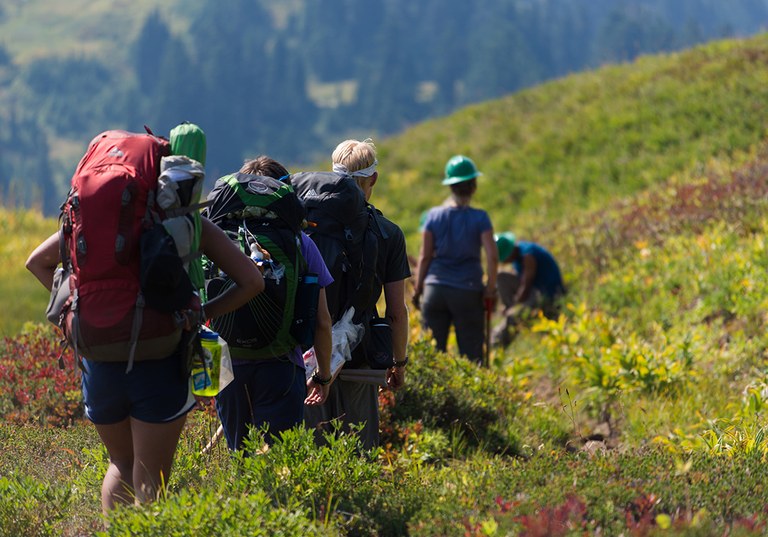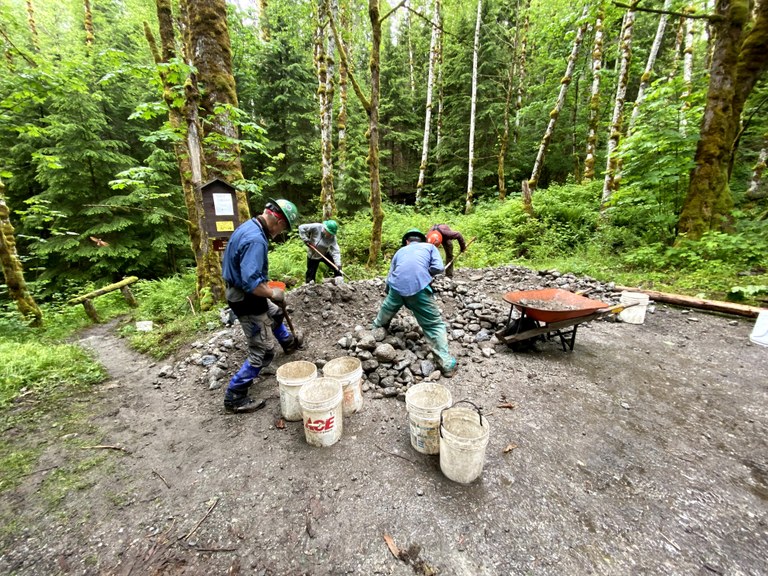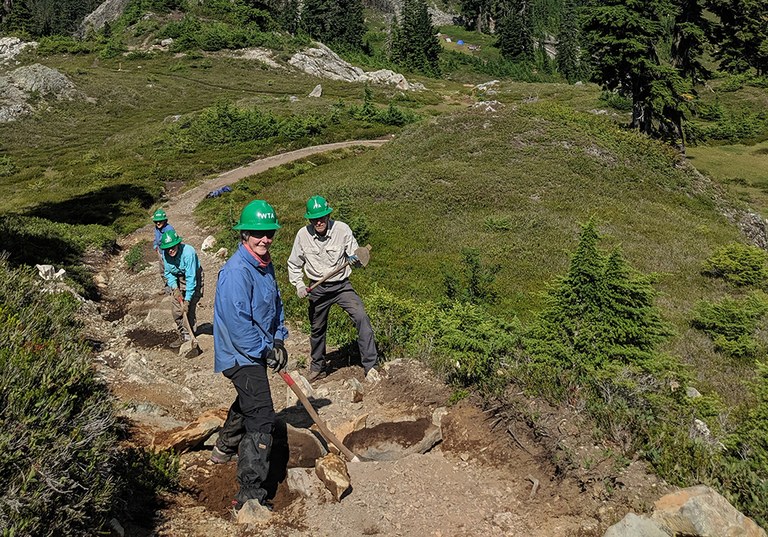Frequently Asked Questions about Backcountry Response Teams
What is a BCRT?
Backcountry response teams (BCRTs) are 3-8 day overnight work parties. Participants bring and carry all the gear required for a multi-night backpacking trip, including a tent, a sleeping bag, cooking gear and all the food they will need.
What are the benefits of volunteering with WTA?
Work parties are a great way to get some exercise outdoors while helping keep Washington's trails hikeable. At the end of the day you can see how much you’ve accomplished and feel good about improving a wonderful resource for others to enjoy well into the future. We do also give out swag!
Who can register for a BCRT?
WTA welcomes anyone interested in doing trail work; however, due to the nature of these trips there are some specific requirements to ensure that everyone has a safe trip. Here's what it takes to join a BCRT:
- The physical conditioning to hike with a fully-loaded backpack and be physically active for about 8-9 hours a day on uneven terrain
- Weather appropriate backpacking gear and enough food for the duration of the trip
- Prior backpacking experience including the ability to run your own camp following Leave No Trace principles
- Participation in the full length of the trip. Arriving late or leaving early is not allowed
- Flexibility: Weather and land manager priorities can change the project last minute
- The ability to work with a team
- Attending at least one day work party is encouraged to try out trail work before committing to a full week.
- Minimum age is 18

A BCRT crew in poses on trail. Photo by Emily Snyder.
How do I register?
In 2025, registration for all BCRTs open February 22 at 10:00 a.m. Be ready for registration by doing the following:
- Create or access your My Backpack account. For more info about My Backpack, check out these FAQs.
- Complete your Backcountry and Medical forms. To find these go to your My Backpack account, click on “My Work Parties” then look under “Crew Leader Corner” on the right. Make sure to do this in advance of registration day.
If you have already completed the Backcountry Form last year, your answers will be saved; update them as needed. The Medical History Form must be resubmitted annually. - Find the trip you want and click “Join Work Party,” fill out the registration form and you’re all signed up!
Note: For BCRTs marked 'Strenuous', you will complete a screening call with one of our staff before being registered. - Still have questions? Contact us at volunteer@wta.org or 206-625-1367.
Can my group of friends and I join together?
You can register up to one additional person with you when signing up for a trip. They must have a My Backpack account with completed backcountry experience and medical history forms.
The trip I want to go on is full. Is there a waitlist?
Yes! Any trip that is accepting volunteers for a waitlist will be indicated as “Full - Join Waitlist.” Hit the “Join Waitlist” button and complete the registration form to be added. We'll email you if a spot opens up.
How much does it cost?
BCRTs are free for participants. However please remember WTA staff and volunteers invest a lot of time and resources preparing for each project based on the number of registered volunteers. We count on all registered volunteers to show up. No-shows can seriously affect the effectiveness of the rest of the crew.
Can I join multiple BCRTs?
Yes, but please only register for work parties you are confident you can participate in. Remember that you must be able to stay for the full trip; no late arrivals or early departures are permitted.
What is your cancellation policy?
It's very important that each volunteer show up for the BCRT they've registered for. Each person is crucial to the completion of the project. We hope you don't have to cancel, but if you do, please do so with enough time that someone else can take your spot. No-shows can be stressful for the crew leader and sometimes means the project doesn't get done.
But we also understand life happens and sometimes you can't avoid cancelling. If you do need to cancel, please do so using your My Backpack account. Alternately, you can find the cancellation link in the initial work party registration email you received. If you can't do either of these, you can email volunteer@wta.org to cancel your registration.

Hiking to your worksite each day can offer a great view. Photo from WTA archives.
How many people are on a trip?
Crew size can vary depending on the number of sign-ups and the project location, but a typical crew size is between 6 and 12 people including the crew leader. This is due to Forest Service wilderness regulations capping group size at 12.
I don’t know anyone on my crew. Are people friendly?
Yes! WTA work parties foster a friendly and social atmosphere where you will get to know the people you are working alongside.
WHat is our camp like?
This changes for each backcountry trip. At many of our locations, you’ll have your choice of gorgeous spots to pitch your tent. However, some backcountry trips have space restrictions due to the sensitivity of the landscape we are in. In these cases, you may be camped fairly close to your fellow volunteers.
Details about camp are often sent as the trip gets close. After you sign up, look for an email from your crew leader with details about the trip, including camping options.
How hard is a BCRT?
All BCRTs are a challenging mix of backpacking and trail work, but the parameters of each trip are different. The trip description indicates whether you will be backpacking into a basecamp or moving camp throughout the trip. The descriptions also address the expected daily hike to the work site. Information about hiking distance and elevation gain is included whenever possible to help you choose a trip that best fits your abilities and goals.
A day's trail work can be physically demanding if you are not accustomed to it — especially after hiking with a fully loaded backpack and heavy trail tools. We strongly encourage you to try a day work party before committing to a full week of trail work.
If you have a health condition that might be aggravated by physical exertion and cannot be controlled at a safe level while in the field, a Backcountry Response Team trip is probably not the right fit for you.
What does it mean when a trip is marked "strenuous"?
A strenuous rating means the trip will be especially challenging due to the mileage, elevation gain and/or duration. Participants should be comfortable traveling long distances over steep terrain, performing physically taxing tasks for multiple days, having limited access to communication and living for an extended period in a backcountry setting. Participants on a trip rated as strenuous must meet fitness and experience criteria, and will have a one-on-one conversation with a WTA trail maintenance staff member before being approved for participation.
What do past participants have to say about BCRTs?
Past participants come away from a BCRT with lasting memories and new friendships. The best review is the fact that many volunteers return for BCRTs year after year.
This sounds too hard for me but I still want to do trail work. Do you offer another option?
Volunteers are always welcome to join a day work party. This year, we are also piloting some Intro BCRTs, which are shorter than average trips that feature shorter miles to camp or the project.
If you'd like multiple days of trail work without the camping, keep an eye out for the occasional weekend work party. Week-long volunteer vacations (most of which include frontcountry camping) are also another option.
How can I get in shape for a BCRT?
Read our tips for physical conditioning and where to find a trail to get started. It’s also a good idea to come out to some one-day work parties to get practice doing trail work.
It’s been a while since I went backpacking. How can I brush up on my skills?
Read our Backpacking 101 tips and check out our Trail Smarts page for a crash course in backcountry travel. You might also try an overnight trip to test your gear and get reacquainted with Leave No Trace practices.
What should I bring?
Volunteers must be equipped with and able to carry all gear required for multiple nights on the trail. You may already have your own preferred packing list, but please make sure it includes the items on our BCRT packing list.
You must also arrive with the skills to be self-sufficient and follow Leave No Trace principles in camp, from cooking your meals and keeping your food safe from wildlife to managing waste.
DO I NEED BEAR SPRAY?
This is a personal choice. WTA does not require or provide bear spray. However, some project locations require bearproof food storage, and this may help you decide whether you bring spray. It's worth considering that bear spray is rarely necessary when recreating in Washington, and incorrectly stored or deployed bear spray can pose a much greater danger than bears do.
What does WTA provide?
WTA provides all the tools and hardhats needed to do the work safely and effectively. We also plan the project and where the crew will camp. It is up to volunteers to bring everything else they will need, including a tent, a sleeping bag, cooking equipment, all food, water filtration, work gloves and safety glasses.

Volunteers join together to move a mound of rocks and gravel into position on a BCRT at North Fork Sauk Falls. Photo by Emily Snyder.
I want to join but I don’t have any gear. What can I do?
Consider buying used gear, renting gear, or borrowing from your friends and neighbors. Just be sure to test everything before the trip and know how to use it.
What kind of project will I be working on?
Backcountry response teams tackle a range of trail maintenance projects. Each trip description indicates the type of work that is planned. Whatever the project, you’ll be amazed at what you and your fellow volunteers accomplish by the end of the week! Check out WTA’s Trail Work Guide for an introduction to basic trail maintenance concepts.
What is the day-to-day schedule like?
The schedule for each trip varies depending on the length, the project, and weather conditions. Your crew leader will be in touch with details before your trip. Typically, a BCRT schedule looks something like this:
Day 1
- Meet the crew at the trailhead for introductions and a safety briefing. Pick up tools and begin the hike to camp. (Specific meeting time and location will be confirmed in advance).
- Arrive at camp, set up your tent and break for lunch.
- If camp is reached by midday, hike to work site to begin the project.
- Return to camp with plenty of time to prepare your dinner. Enjoy the evening getting to know the crew or retire to your tent with a good book.
Day 2 and Beyond
- 6:30 – Rise and shine, make your breakfast and pack your lunch.
- By 8:00 – Leave camp with the crew for the hike to the work site.
- 8:30-9:00 – Begin work on the project, taking periodic breaks.
- Noon - Lunch break
- Afternoon - Continue trail work, stopping periodically for breaks. Depending on the project and the weather, work may end at different times each day.
- 4:00-5:00 – Arrive back at camp to unwind.
- Evening – Prepare your own dinner, hang out with the crew to swap backpacking tips and stories or stargaze before you retire for the night.
Final Day
- 6:30 – Rise and shine, eat breakfast, pack your lunch and break down camp.
- By 8:00 – Leave camp with the crew for the hike to the work site.
- 8:30-9:00 – Begin last day of work to complete the project.
- Noon - Lunch break
- Afternoon – Hike with the crew back to the trailhead and say goodbye.
How do I get to the trailhead?
Each volunteer is responsible for finding their own way to the meet-up location (which may or may not be the actual trailhead). When you register you can indicate if you would like to carpool and we will connect you with other volunteers who would like to carpool. Coordinating the details of the carpool is up to you. Carpooling is not required. On certain trips, the crew may need to caravan from the meet-up location to the trailhead. Participants will be notified of all these details in advance of the start day.
Who are the leaders? And how many?
There will always be one main leader who will be wearing a blue hat. The crew leader's name can be seen from the work party trip page. If a trip says "WTA Crew Leader" on the trip page, it means that a crew leader has not yet been assigned. Get to know who will be leading your trip. The number of assistant crew leads (ACLs), who will be wearing orange hats, varies on the trip but we always try to have a good ratio of leaders to participants.

You and your crew will get to work in gorgeous settings during the day and camp in the same spot by night! Photo by Owen Vogeli.
Will there be pack animals on the trip?
Pack animals are not usually a part of a BCRT, so it is unlikely that you will encounter them. Sometimes we work with Back Country Horsemen of Washington on trails that are open to equestrian use so it is possible that trail users will be coming by on horses. Be sure you understand the right-of-way on trail in case you do come across a horseback rider.
What can I do during my free time?
The majority of the day will be spent doing trail work with your crew but there will be some downtime at the beginning and end of the day. It's your free time, do what you want to do (safely of course). Hike on your own or with a friend, read a book, play cards, sleep, relax, tidy up camp, watch clouds. If you're leaving camp, you should let the crew leader know what your itinerary and when you'll be back. Volunteers will be expected back at camp by a designated time.
Will there be a toilet?
No. You should expect to bury your waste following Leave No Trace guidelines. Sometimes these are different when you're in a large group; get an idea of how BCRTs typically manage waste from our blog about backcountry poop. There may be an outdoor toilet maintained near your worksite or campsite depending on the trip, or you may need to use blue bags and carry your waste out with you. Your crew leader will let you know if this is the case.
What is the alcohol policy?
The consumption of alcoholic beverages is not permitted before or during the work day. Consumption of alcoholic beverages after the work day is discouraged to ensure a safe, positive experience for all volunteers and requires moderation by the user; anyone abusing this rule will be directed to leave if the conduct persists. Please be respectful of others.
What is WTA's policy on firearms and weapons?
Volunteers are not allowed to bring firearms or weapons on a BCRT trip (regardless of whether they are licensed to carry a concealed weapon).
What other rules are there?
We want our work parties to be inclusive and welcoming for everyone. We ask that volunteers be respectful of everyone on the trip and contribute to a culture of caring and understanding. You can always talk with your crew leader if someone is making you feel uncomfortable or unsafe.
Who do I contact if I have more questions?
Email us at volunteer@wta.org or call 206-625-1367.

